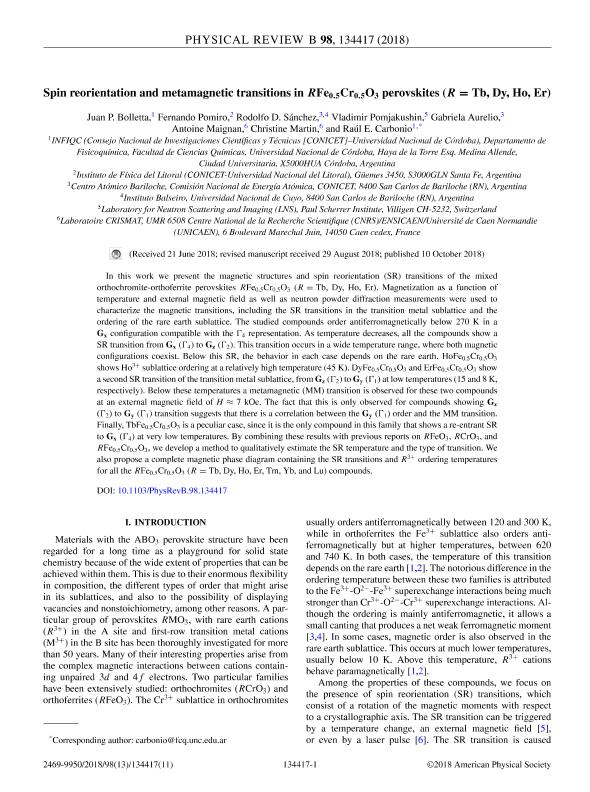Mostrar el registro sencillo del ítem
dc.contributor.author
Bolletta, Juan Pablo

dc.contributor.author
Pomiro, Fernando

dc.contributor.author
Sanchez, Rodolfo Daniel

dc.contributor.author
Pomjakushin, Vladimir
dc.contributor.author
Aurelio, Gabriela

dc.contributor.author
Maignan, Antoine
dc.contributor.author
Martin, Christine
dc.contributor.author
Carbonio, Raul Ernesto

dc.date.available
2019-12-02T18:05:37Z
dc.date.issued
2018-10
dc.identifier.citation
Bolletta, Juan Pablo; Pomiro, Fernando; Sanchez, Rodolfo Daniel; Pomjakushin, Vladimir; Aurelio, Gabriela; et al.; Spin reorientation and metamagnetic transitions in R F e0.5 C r0.5 O3 perovskites (R=Tb, Dy, Ho, Er); American Physical Society; Physical Review B; 98; 13; 10-2018; 134417-134428
dc.identifier.issn
2469-9969
dc.identifier.uri
http://hdl.handle.net/11336/91095
dc.description.abstract
In this work we present the magnetic structures and spin reorientation (SR) transitions of the mixed orthochromite-orthoferrite perovskites RFe0.5Cr0.5O3 (R=Tb, Dy, Ho, Er). Magnetization as a function of temperature and external magnetic field as well as neutron powder diffraction measurements were used to characterize the magnetic transitions, including the SR transitions in the transition metal sublattice and the ordering of the rare earth sublattice. The studied compounds order antiferromagnetically below 270 K in a Gx configuration compatible with the Γ4 representation. As temperature decreases, all the compounds show a SR transition from Gx (Γ4) to Gz (Γ2). This transition occurs in a wide temperature range, where both magnetic configurations coexist. Below this SR, the behavior in each case depends on the rare earth. HoFe0.5Cr0.5O3 shows Ho3+ sublattice ordering at a relatively high temperature (45 K). DyFe0.5Cr0.5O3 and ErFe0.5Cr0.5O3 show a second SR transition of the transition metal sublattice, from Gz (Γ2) to Gy (Γ1) at low temperatures (15 and 8 K, respectively). Below these temperatures a metamagnetic (MM) transition is observed for these two compounds at an external magnetic field of H ≈ 7 kOe. The fact that this is only observed for compounds showing Gz (Γ2) to Gy (Γ1) transition suggests that there is a correlation between the Gy (Γ1) order and the MM transition. Finally, TbFe0.5Cr0.5O3 is a peculiar case, since it is the only compound in this family that shows a re-entrant SR to Gx (Γ4) at very low temperatures. By combining these results with previous reports on RFeO3, RCrO3, and RFe0.5Cr0.5O3, we develop a method to qualitatively estimate the SR temperature and the type of transition. We also propose a complete magnetic phase diagram containing the SR transitions and R3+ ordering temperatures for all the RFe0.5Cr0.5O3 (R=Tb, Dy, Ho, Er, Tm, Yb, and Lu) compounds.
dc.format
application/pdf
dc.language.iso
eng
dc.publisher
American Physical Society

dc.rights
info:eu-repo/semantics/openAccess
dc.rights.uri
https://creativecommons.org/licenses/by-nc-sa/2.5/ar/
dc.subject
SPIN
dc.subject
REORIENTATION
dc.subject
METAMAGNETIC
dc.subject
PEROVSKITE
dc.subject.classification
Física de los Materiales Condensados

dc.subject.classification
Ciencias Físicas

dc.subject.classification
CIENCIAS NATURALES Y EXACTAS

dc.title
Spin reorientation and metamagnetic transitions in R F e0.5 C r0.5 O3 perovskites (R=Tb, Dy, Ho, Er)
dc.type
info:eu-repo/semantics/article
dc.type
info:ar-repo/semantics/artículo
dc.type
info:eu-repo/semantics/publishedVersion
dc.date.updated
2019-09-30T18:26:47Z
dc.identifier.eissn
1098-0121
dc.journal.volume
98
dc.journal.number
13
dc.journal.pagination
134417-134428
dc.journal.pais
Estados Unidos

dc.description.fil
Fil: Bolletta, Juan Pablo. Consejo Nacional de Investigaciones Científicas y Técnicas. Centro Científico Tecnológico Conicet - Córdoba. Instituto de Investigaciones en Físico-química de Córdoba. Universidad Nacional de Córdoba. Facultad de Ciencias Químicas. Instituto de Investigaciones en Físico-química de Córdoba; Argentina
dc.description.fil
Fil: Pomiro, Fernando. Universidad Nacional del Litoral; Argentina. Consejo Nacional de Investigaciones Científicas y Técnicas. Centro Científico Tecnológico Conicet - Santa Fe. Instituto de Física del Litoral. Universidad Nacional del Litoral. Instituto de Física del Litoral; Argentina
dc.description.fil
Fil: Sanchez, Rodolfo Daniel. Consejo Nacional de Investigaciones Científicas y Técnicas; Argentina. Comision Nacional de Energía Atómica. Gerencia de Área Investigaciones y Aplicaciones no Nucleares. Gerencia de Física (Centro Atómico Bariloche). División Resonancias Magnéticas; Argentina
dc.description.fil
Fil: Pomjakushin, Vladimir. Universidad Nacional de Cuyo; Argentina
dc.description.fil
Fil: Aurelio, Gabriela. Comision Nacional de Energía Atómica. Gerencia de Área Investigaciones y Aplicaciones no Nucleares. Gerencia de Física (Centro Atómico Bariloche). División Física de Metales; Argentina
dc.description.fil
Fil: Maignan, Antoine. Université de Caen Normandie; Francia
dc.description.fil
Fil: Martin, Christine. Université de Caen Normandie; Francia
dc.description.fil
Fil: Carbonio, Raul Ernesto. Consejo Nacional de Investigaciones Científicas y Técnicas. Centro Científico Tecnológico Conicet - Córdoba. Instituto de Investigaciones en Físico-química de Córdoba. Universidad Nacional de Córdoba. Facultad de Ciencias Químicas. Instituto de Investigaciones en Físico-química de Córdoba; Argentina
dc.journal.title
Physical Review B

dc.relation.alternativeid
info:eu-repo/semantics/altIdentifier/url/https://journals.aps.org/prb/abstract/10.1103/PhysRevB.98.134417
dc.relation.alternativeid
info:eu-repo/semantics/altIdentifier/doi/http://dx.doi.org/10.1103/PhysRevB.98.134417
Archivos asociados
